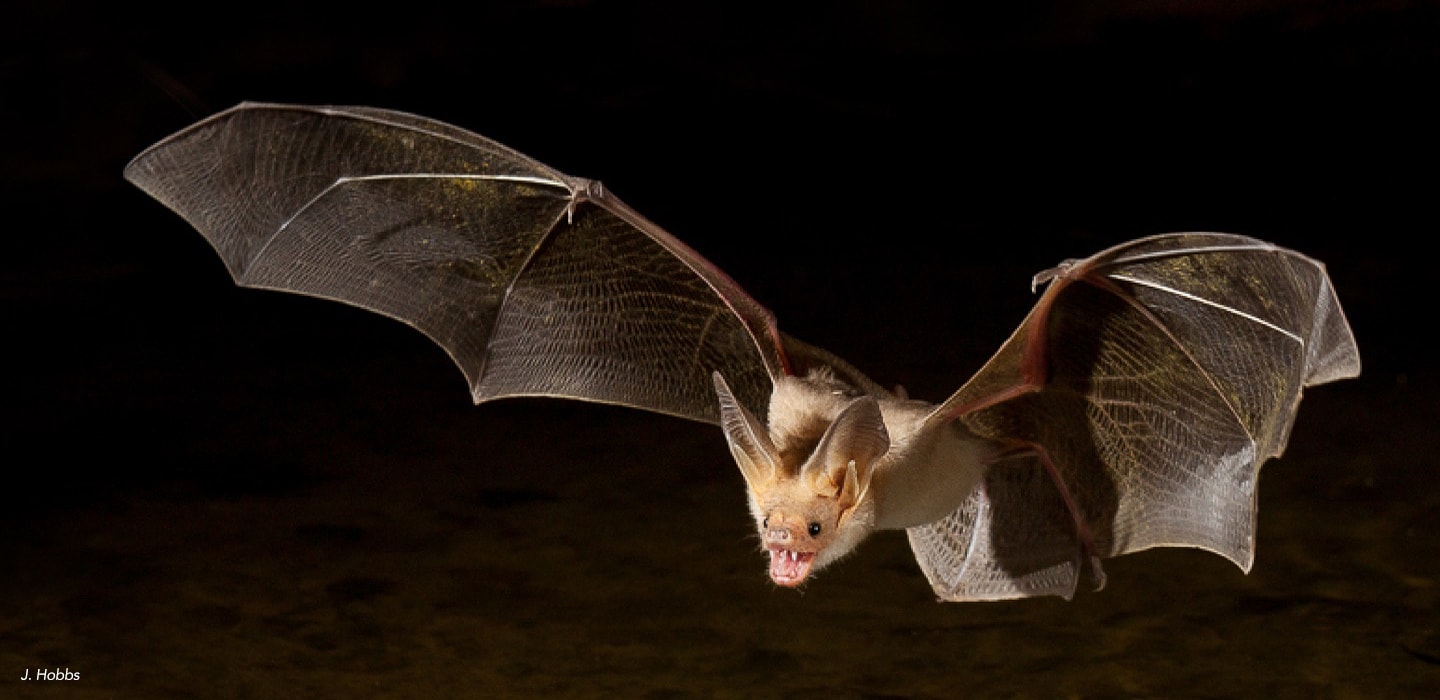Researchers funded by FWCP caught at-risk Spotted Bats. These bats, rarely caught, provided valuable information that will help conservation planning when White Nose Syndrome arrives in BC. The fatal fungus is devastating bat populations.
Spotted bats weigh about the same as four nickels, despite oversized ears bigger than any other bat that lives in B.C. They’re also known for being extremely hard to capture.
But last August, a team of bat specialists used a specialized 12-metre net strung between poles to capture seven spotted bats near Lillooet. Supported by funding support from the Fish and Wildlife Compensation Program (FWCP), the capture was considered a coup, given that fewer than 20 had been previously captured in Canada.
“Finding six spotted bats in one night, and seven in total this field season, is beyond our expectations,” said biologist Jared Hobbs, who works with environmental consultancy Hemmera, co-leader of the project with bat biologist Dr. Cori Lausen.
Like other bats in B.C., the spotted bat is a small nocturnal animal that plays an important role in insect control. Spotted bats in particular are adept at eating moths, many species of which are considered forest and crop pests. Studies in the U.S. have estimated the value of pest-control to agriculture, provided by bats in the U.S. alone, to range from a low of $3.7 billion to a high of $53 billion a year.
Globally, bats also contribute to the ecosystem by acting as pollinators and helping to disperse seeds. Unique among bats in Canada, spotted bats are the only species to produce hunting calls audible to the human ear, a trait that is thought to have evolved to prey on moths that hear high frequencies produced by all other bats.
“Spotted bats are at-risk and continue to be a species of special concern nationally,” says Trevor Oussoren, a manager with FWCP, a program set up to compensate for the impacts to fish, wildlife and their supporting habitats affected by BC Hydro owned and operated generation facilities. “Their habitat has been impacted in a variety of ways, including from dam construction. This work, which involved many volunteers, has successfully identified important bat roosts that can be monitored, and possibly protected, in the future.
“Projects like this contribute to the scientific understanding of a species, and will help the decision makers who manage species and ecosystems.”
Research should help prepare for White Nose Syndrome, expected to arrive in BC
Once the bats were captured, researchers placed small radio transmitters on them to trace their movements. The resulting data will help researchers learn more about the roosting and foraging habits of spotted bats.
The research will help better prepare for the effects of White Nose Syndrome — a devastating fungal disease that has been killing North American bats by the millions. The disease is expected to arrive in B.C. within five to 10 years.
The FWCP is a partnership between BC Hydro, First Nations, public stakeholders, the Province of B.C. and the Department of Fisheries and Oceans. It operates in the Coastal, Columbia and Peace regions of B.C. This research helps fill important data gaps and contributes to the FWCP’s vision of ensuring that fish and wildlife thrive in watersheds that are functioning and sustainable.
A few facts about spotted bats
- Spotted bats, whose voice is a soft, high-pitched metallic squeak or chirp, are one of the few bat species to emit echolocation calls audible to the human ear.
- Spotted bats feed primarily on flying moths, and drink on the fly by skimming the surface of open water sources such as ponds lakes and open water tanks.
- Initially thought to be extremely rare, spotted bats are now known to occupy a range throughout central western North America, from southern British Columbia to northern Mexico.
- Spotted bats are extremely hard to capture because of their habit of roosting high in cliff crevices.
When eating, spotted bats pull the tough heads and wings from moths before consuming the tender abdomens.


